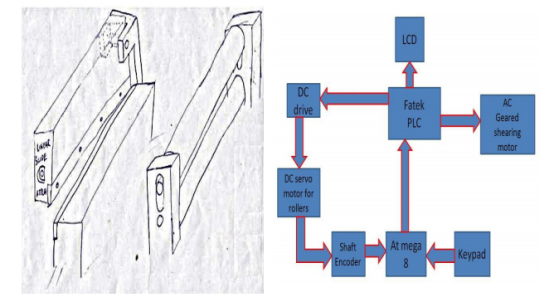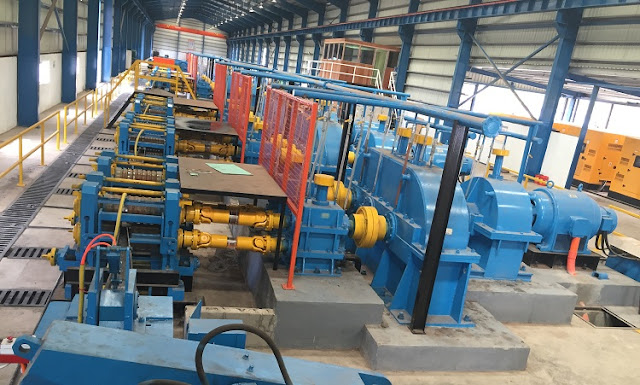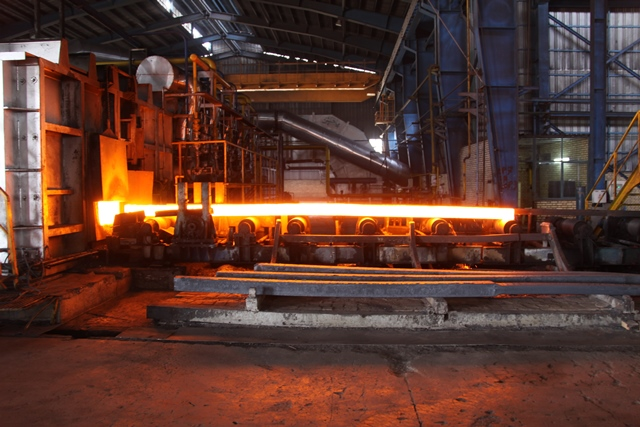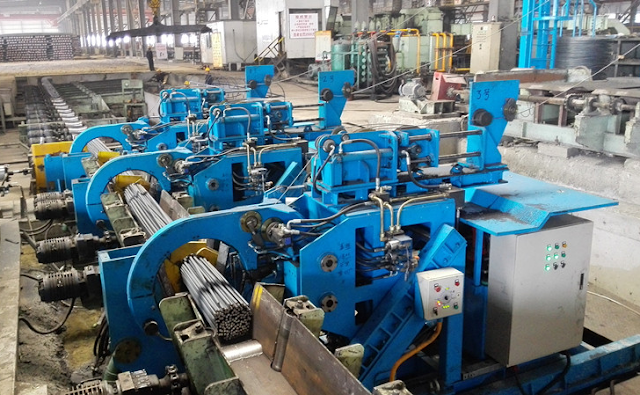300000 Ton Bar Rolling Mill Production Line Technology
1. Raw Materials: Continuous Casting Billets
The raw materials used in the workshop are qualified continuous casting billets, which are provided by the steel-making and continuous casting workshop adjacent to the workshop, and there are hot billets and cold billets. The hot billet enters the workshop through the hot delivery roller table to realize the hot delivery and hot charging, and the furnace temperature is about 600 ℃. The cold billets are transported from the steel-making and continuous casting workshop to the raw materials in the workshop by the cross span electric flat car.
The steel-making and continuous casting workshop shall provide flawless continuous casting billets, and the quality of continuous casting billets shall meet the requirements of yb2011-2004.
The annual demand for the workshop is 313000 tons.
Specification of continuous casting slab: 130mm × 130mm × 12000mm single weight: 1592kg
Short scale material ≮ 10000mm, the total amount is not more than 10%.
2. Bar Rolling Mill Production Process
2.1 Production Process Characteristics and Advanced Technology
(1) With continuous casting slab as raw material, continuous, non-twist and high-speed rolling is adopted in the whole rolling line, and the maximum rolling speed is up to 18m / s.
(2) The short stress line is selected for all rolling mills, which is characterized by high rigidity, the long service life of roller bearing, whole stand replacement and short roll change time.
(3) The small-sized ribbed bar products are mainly produced by slitting rolling process, which can obtain a higher output with lower rolling speed and can produce small-sized products with fewer rolling mills.
(4) There are flying shears behind the roughing mills, intermediate and finishing mills. During the rolling process, the head and tail of the rolled piece are cut; In front of the roughing mill, there is a clipper. In case of an accident, the mill can be broken to protect the mill and deal with the accident conveniently. Each flying shear adopts a start-stop working system, which has high shearing accuracy, low accident rate, and less maintenance.
(5) After finishing mill, water-cooling equipment is reserved, which is used for the residual heat treatment of surface quenching core heat tempering of ribbed steel bar products after rolling, so as to improve the mechanical properties and strength grade of products.
(6) After rolling, the bar is cooled on the step rack type cooling bed, and the bar is evenly cooled with good straightness; the unloading device of the cooling bed has a steel discharging device, which can arrange the bars of the lower cooling bed evenly, so as to facilitate the rear finishing treatment.
(7) The fixed-length shear of the finished product is 500 tons stop shear, which has a large shear capacity and can meet the requirements of high output of the rolling line.
(8) The bar rolling mill line equipment is controlled by an advanced computer system, which has complete control functions, high-quality electrical products, short commissioning cycle, fast production, and efficiency, and has reached the international advanced level.
2.2.2 Process Flow
The whole bar rolling mill line equipment is arranged on the + 5.00m elevated platform, and the elevation of the rolling center line is + 5.80m.
Description of the Production Process
(1) Loading Billets
The cold billets are transported to the raw material span of the workshop from the steel-making and continuous casting workshop adjacent to the workshop by the over span electric flat car, and the billets are lifted to the raw material span by the electromagnetic disk crane.
When using the cold billet production, the electromagnetic crane will lift the billet in rows and put it on the feeding platform. The feeding platform will place the billets on the furnace roller table one by one.
After the hot billet is sent to the workshop from the continuous casting workshop through the hot delivery roller table, it is lifted from the + 0.05m hot delivery roller table to the furnace roller table by a hoist.
In the process of transportation on the roller table, the billets are measured and weighed one by one. For the unqualified blank (manual visual inspection, surface defects, excessive bending, which do not meet the requirements), it can be removed by the removal device set at the side of the furnace roller table. The qualified billets are pushed into the heating furnace by a pusher in rows from the roller table.
According to the heating process of different steel grades, the billets are heated to 980-1150 ℃ and then sent out from the side of the heating furnace by roller according to the rolling rhythm.
 (2) Rolling
(2) Rolling
The billets after discharging are transported by the discharging roller table and rolled in the roughing mill ( 500 × 4 + 400 × 2) arranged by 6-stand flat/interchange. Then it is sent to the medium rolling mill ( 400 × 4 + 350 × 2) arranged in the flat / interchange of 6 stands for medium rolling after 1 × flying shear head and tail. The rolled piece comes out of the intermediate rolling mill and passes through the 2 × flying shear head and tail, and then is sent to the 6 stands finishing rolling mill ( 350 × 6) for rolling. Two of them are the horizontal/vertical convertible rolling mill for slitting rolling.
The roughing mill and the middle rolling mill are micro tension rolling. The front of the finishing mill and the front of each stand are equipped with vertical loopers. The rolling piece is rolled here without tension to ensure the dimensional accuracy of the rolling piece.
When there is a fault in the downstream of the rolling line, 1 × 2 × flying shears will start automatically to cut continuously, and the rolling piece will be broken to prevent the accident from further expanding. In front of the roughing mill, there is an accident clip shear, which automatically cuts off the rolled piece in case of an accident.
 3) Water Cooling Device (Reserved)
3) Water Cooling Device (Reserved)
The ribbed bars and bars coming out of the finishing mill immediately enter the water-cooling device for on-line residual heat quenching treatment (if water-cooling is not required, they can be emptied). That is to say, the rolling piece is forced to be cooled by the water-cooling box to make its surface temperature drop sharply to about 300 ℃, forming the martensitic structure. After the cold box is discharged, the heat of the core of the rolled piece disperses to temper the martensite structure on the surface, and finally, the tempered martensite structure on the surface and the fine pearlite structure on the core are obtained. The product of this structure has high tensile strength and can increase the strength of ribbed steel bars. According to the product requirements of different steel grades and specifications, the number of using sections and water volume of the water-cooling device is set to achieve the required rolling temperature.
(4) Segments
The finished rolled piece is clamped by the pinch roll and sent to the multiple lengths segmented flying shear (3 × flying shears). The multiple length segmented shear is optimized and cut into multiple lengths of the cooling bed.
The rolled piece after multiple length and section is sent to 78 × 9m step rack type cooling bed by the cooling bed input roller table and steel throwing (brake apron) device, and the rolled piece is cooled naturally while stepping on the cooling bed. Before lowering the cooling bed, align one end of the rolled piece with the output direction of the cooling bed by aligning the roller track, and then form a steel group in rows by the unloading chain conveyor according to a certain distance and quantity, and send it to the output roller track of the cooling bed in rows by the steel transfer trolley device.
(5) Cut to Size and Collect
The output roller table of the cooling bed will transport the group of steel unloaded from the cooling bed to the cold stop shearing place. The steel will be cut to the fixed-length by the fixed-length machine and the cold stop shearing (among which the hole type shear blade is recommended for the rolled piece with the specification of ≥ 25mm).
The fixed-length material is transported by the sheared roller table and transported to the finished span by the traverse chain stand. A set of short-scale roller table is arranged on the side of the transverse moving platform, which can be used to collect the short scale materials sandwiched in the fixed scale materials.
The traverse platform is composed of three groups of chain conveyors. The fixed-length materials are inspected and sorted during the transportation of the platform, and then they are collected on the collection roller with the vertical roller, which will deliver the collected bars to the baler for bundling, and finally to the collection platform for weighing, labeling, and collection of steel bundles. The bundles of finished bars are hoisted by the crane in the finished product warehouse to the finished product span for stacking.
The cutting head and broken materials are collected in the cutting headbox, lifted to the car by the crane, and then transported out of the workshop by the car. A kind of
In the rolling process, the size sample is selected manually on the cold bed, and the test sample is selected at the cold shear.
Whatsapp/Wechat:+8615877652925




























